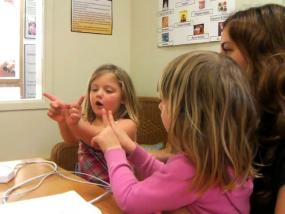Conducting a Wind Choir of Friends

The children in this video have been involved in a long-term investigation about wind. They have explored wind sounds and experimented with creating their own wind choir using their voices. The children previously watched videos of children’s choirs and orchestras and revisited videos of themselves creating their wind choir. They studied the conductor in the videos and began to explore this role with their friends. Watch how the children understand the conductor’s role as they take turns organizing and guiding their friends’ wind sounds. They create symbols with their fingers. The meaning of these gestures emerge through a reciprocal process of the choir following the conductor and the conductor accommodating to the choir with some minor scaffolding by the teacher. The teacher asks Harriet to conduct how loud the children should sing. She begins with open palms, moving back and forth in rhythm with the wind sounds the children make, perhaps an easier place to start than conducting loud or soft. At 00:15 she pauses, perhaps realizing something is not quite right. She makes a more definitive gesture with her extended right index finger, swiping it back and forth like a metronome. Harriet stops moving her hand, and the teacher labels this action as significant. The children stop singing. Harriet understands that "not moving" the hands at all is itself a weak symbol, so she creates more "readable" finger poses. She says, "X means stop and lines means go," using her two index fingers to demonstrate with crossed fingers and parallel fingers respectively. It takes one failed trial by the choir to learn the meaning of X. The choir starts again as Harriet holds her fingers in the parallel pose. She moves her arms such that her finger poses are directly in front of each singing child in turn, the way a teacher would move an open book so each child could see the picture. Perhaps she misses making movements during the singing the way real conductors do. Perhaps she is gently imposing her conducting role by "presenting" the symbol to each child in turn. After a few measures of wind sounds Harriet, with a sharp quick movement, crosses her fingers at the end of one of the motifs the children have repeated six or seven times. She does not stop them at an arbitrary place. The children stop instantly. Harriet is very pleased. The second child wants to conduct, and the teacher asks for "go" and "stop" signals. Wide arms mean go, and crossed arms mean stop. She also sings the phrase she wants the choir to repeat: a low high, low high repeating phrase. It is different than the previous phrase Harriet directed. Her open arm symbol morphs into a control of when to sing low (lowers her arms) and when to sing high (raises her arms). The meaning seems to flow from a common mindset between the conductor and the choir without premeditation. She is so delighted that she squeals (01:25). The children have created gestures that start the singing, stop the singing, set the rhythm, and now control the pitch of the singing as well. By the time the third child conducts, all the children understand the structure of the game. One needs to clearly define what each gesture means: start, stop, high, low. But one does not have to use the same symbols as the previous conductor. Indeed, symbols are no less than a social contract, an agreement to treat X as a stand in for Y. The meaning of a symbol can also emerge spontaneously, as long as the conductor and the choir accommodate to each other, as you see when the third child begins to make vigorous circles with her arms (02:30). Younger children are a bit literal about symbols and fail to understand how one could still communicate if we decided to call a person by another name. Younger children feel that someone's name has the same communicative status as the person's face and should not be changed. These young girls are playing a meta-symbolic game of renaming the symbols for start, stop, high, and low. The meta-symbolic aspect of this play justifies the episode as educational, as well as fun. We can also see dimensions of emergent leadership in the children’s play, learning how to communicate, to be patient with your learners, to project your authority when conducting. All and all, this is an extremely informative two and a half minutes. Length of Video: 2 minutes 41 seconds Keywords: Fives, Sound, Music, Symbols, Gestures, Leadership
